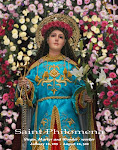
The long list of names which we have just heard is the family tree of the Lord Jesus. This line of ancestors shows us how God has prepared a human family into which his Son will be born. 42 generations became part of that long preparation for the coming of the Savior. Truly, this is history in a glance and simply looking at the names does not do justice to the entire story. It is only when we read the Bible that we shall appreciate the fact that every name in this list brings with it a unique and unrepeatable story. Each story might seem to be unrelated to the other and yet, when the names are listed in a genealogy, suddenly it dawns upon us that these stories tend toward the same goal: the birth of the Promised One. The entire family tree moves towards Jesus, the Son of Mary, the one who is called the Christ.
However, the story of this family does not end with Christ. It is true that Jesus never got married and never begot children of his own flesh. The irony of this is that it is Jesus who expands the family and brings to fulfillment the Divine promise to Abraham that he shall have descendants as numerous as the stars in the heavens and as the grains of sand on the shore of the sea. How did our Lord expand this family? He did it by changing the manner of affiliation into this family. Before he came, the affiliation was by relationship of blood. A person enters into this family by birth to a legitimate member of this family. But the Lord Jesus changed this. In his new family, which is the Church, affiliation is by relationship of faith. A person enters into this family of Christ no longer by physical birth but rather by the Sacrament of Baptism, a birth by water and the Holy Spirit. The Church, the new family of Christ, the family begotten not by flesh but by the Holy Spirit, continues to our day and even beyond our days into the end of time, the story of this family of Abraham and the family of David. As in the Old Testament, the ancestors of Jesus pressed forward to bring the plan of salvation to fulfillment, so today, in the New dispensation, the Church, the spiritual family of Christ, “like a stranger in a foreign land, presses forward amid the persecutions of the world and the consolations of God, announcing the cross and death of the Lord comes (cf. 1 Cor 11:26). But by the power of the risen Christ, it is given strength to overcome, in patience and in love, its sorrows and difficulties…so that it may reveal in the world, faithfully, although with shadows, the mystery of the Lord until, in the end, it shall be manifested in full light (Lumen Gentium, 8.)” (Benedict XVI, Porta Fidei, 6.)
The Year of Faith that we shall be celebrating next year will allow us to look at the Church in the very same way we now look at the genealogy of Jesus Christ. The Year of Faith will allow us to retrace “the history of our faith, marked as it is by the unfathomable mystery of the interweaving of holiness and sin. While (the mystery of holiness) highlights the great contribution that men and women have made to the growth and development of the community through the witness of their lives, the (mystery of iniquity) must provoke in each person a sincere and continuing work of conversion in order to experience the mercy of the Father which is held out to everyone.” (PF, 13.) (I really think that retracing the history of our faith is very much needed today considering the fact that as part of the crisis of faith today, there is a seeming denial of the contributions of the Christian faith to humanity. The Pope, for example, usually expresses his concern that Europe is now forgetting its Christian heritage. People have forgotten that European culture is basically Christian. We are not yet in this stage but we are going there.) Indeed, like the Old Testament family to which Jesus was born, “the Church, clasping sinners to its bosom, at once holy and always in need of purification, follows constantly a parth of penance and renewal.” (PF, 6.) And we are those sinners whom the Church clasps into her bosom. We are the ones in need of penance and renewal. In the coming Year of Faith, let us once again look at the history of the Church to discover how faith in Christ transformed the history of the world by trnasforming lives of men and women. In this manner, we shall understand that when we allow our Christian faith to transform us and conform us into the likeness of Christ, we give the Lord the occasion to transform the world we live in. Faith in Christ transforms people. Faith in Christ transforms society. Faith in Christ transforms history.










No comments:
Post a Comment